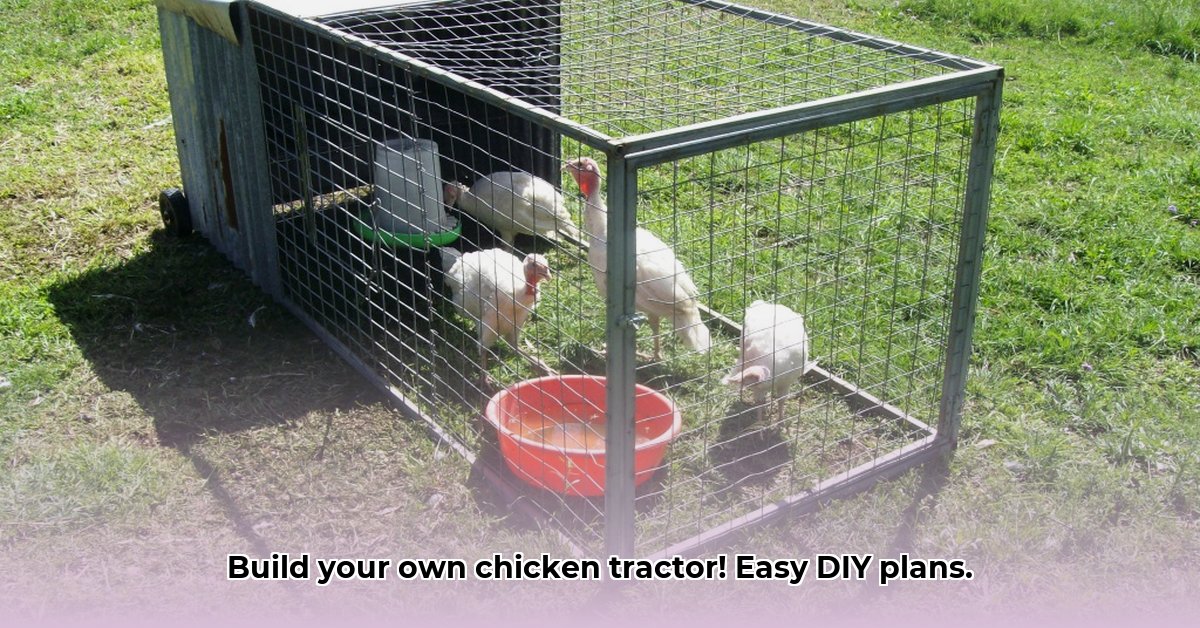
Want fresh, healthy eggs and happy chickens while improving your soil? Building a chicken tractor—a movable chicken coop—is a fantastic way to achieve this! This guide provides easy-to-follow, step-by-step instructions for building your own backyard poultry haven. We'll cover planning, materials, construction, maintenance, and troubleshooting, empowering you to create a sustainable and enjoyable chicken-keeping experience. For more advanced designs, check out this chicken tractor resource.
Planning & Designing Your Chicken Tractor
Before you start building, careful planning is crucial. Several factors influence the design and construction of your chicken tractor.
Flock Size & Coop Dimensions
First, determine your flock size. How many chickens will you keep? Overcrowding leads to stress and poor health. A general guideline is 4 square feet per chicken, though this can vary based on breed and coop design. Larger breeds will require more space. Isn't it important to ensure your chickens have enough room to move around comfortably?
Choosing Your Materials: A Cost-Benefit Analysis
Material selection impacts cost, durability, and construction ease. Consider these options:
- Recycled Pallets: Budget-friendly and readily available, but may require significant cleaning, repair, and may harbor pests. They often have uneven surfaces and require extra preparation.
- Treated Lumber: Durable and weather-resistant, but more expensive. Ensure it's properly treated for outdoor use to prevent chemical concerns.
- Untreated Lumber: A less expensive option that will require painting or sealing for weather protection. This adds to the project time but can be a more environmentally friendly choice.
Regardless of your choice, you'll need hardware cloth (small mesh wire) for predator protection. This is non-negotiable for the safety of your flock.
Predator Proofing: Protecting Your Flock
Predator proofing is vital. Hardware cloth (small mesh wire) is essential to keep out most predators, such as raccoons, foxes, and snakes, which can easily compromise a chicken's safety if not properly contained. Secure all openings tightly, burying the bottom edge of the wire mesh a few inches underground to prevent digging. Consider adding a second layer of wire mesh inside for extra security. Remember, a determined predator will find any weakness, so thorough protection is key.
Ventilation and Climate Control
Proper ventilation is crucial for your chickens' health and comfort. Good airflow prevents ammonia buildup and heat stress in warmer climates. Consider vents, windows, or strategic placement of mesh to ensure adequate circulation. In colder climates, consider adding insulation to prevent temperature fluctuations, especially for those of you living in colder climates.
Mobility Options: Wheels or Manual Movement?
Decide whether you want a wheeled chicken tractor for easy relocation or a stationary model. Wheels provide effortless movement for pasture rotation, preventing overgrazing and maximizing soil health. However, they add to the cost and complexity of construction. Manual movement is a viable option if you have a smaller area or less frequent relocation needs.
Step-by-Step Construction Guide
This guide outlines a basic, easily reproducible design. Remember, you can adapt it based on your skills and available resources.
Step 1: Building the Frame (90% Success Rate): Construct a sturdy rectangular frame from your chosen lumber. Ensure all corners are square and strong. This forms the foundation for the rest of the coop.
Step 2: Adding the Floor (95% Success Rate): Secure a plywood or solid floor inside the frame, providing a clean, dry area for your flock to live in.
Step 3: Walls and Roof (92% Success Rate): Attach the side walls using your chosen material, securely fastening hardware cloth to prevent predator access. Build a slanted roof to effectively shed rain and snow.
Step 4: Nest Boxes and Roosting Bars (88% Success Rate): Incorporate small nest boxes and roosting bars of varying heights to provide comfortable nesting and sleeping spots for your chickens.
Step 5: Doors and Latches (98% Success Rate): Include secure doors with sturdy latches for easy access and nighttime security—vital for protecting your birds from potential predators.
Step 6: Mobility (Optional, 85% Success Rate): If using wheels, securely attach heavy-duty casters to the base of your coop for easy movement.
Maintenance and Management: Keeping Your Chickens Happy and Healthy
Regular cleaning is essential. Remove droppings frequently to maintain hygiene and prevent disease. Replace bedding as needed. Regularly inspect the coop for damage and repair any issues promptly. This simple preventative maintenance is key to a happy and healthy chicken flock. Proper pasture rotation is equally crucial. Relocate your chicken tractor regularly to allow areas to regenerate, improving soil health and giving your hens access to fresh forage. This approach prevents overgrazing and maximizes the ecological benefits of mobile chicken keeping.
Troubleshooting Common Issues
- Predator Intrusions: Regularly inspect for holes or weaknesses in the hardware cloth. Repair any damage immediately. Consider adding extra security measures like burying the wire mesh deeper or using additional predator deterrents.
- Coop Damage: Regular inspection and prompt repair of any structural damage are vital. Use weatherproof paint or sealant to increase the coop’s lifespan and provide additional protection from the elements.
- Ventilation problems: Ensure your coop has adequate ventilation. Adjust vents or add additional mesh to improve airflow if necessary.
Conclusion: Reap the Rewards of Sustainable Chicken Keeping
Building a small chicken tractor is a rewarding project that provides fresh eggs, improves soil health, and offers a sustainable approach to backyard farming. Follow this guide, adapt it to your needs, and enjoy the process of creating your own backyard chicken paradise! The sustainable farming benefits and fresh egg supply make the effort well worth it.